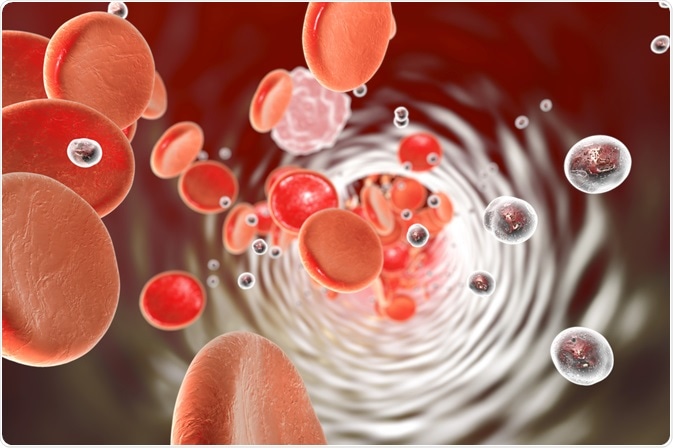Electrochemical biosensors are a class of biosensors that function using an electrochemical transducer. They can detect biological materials such as enzymes, whole cells, specific ligands, and tissues, but also nonbiological matrixes.
 Image Credit: Kateryna Kon / Shutterstock.com
Image Credit: Kateryna Kon / Shutterstock.com
The basics of biosensors
Biosensors are analytical devices that interpret biological information into a quantifiable signal. Biosensors differ from other popular analytical systems, such as high-performance liquid chromatography (HPLC), in that they are self-contained integrated devices. However, biosensors can be incorporated into larger analytical systems. There, they act as a receptor device that can selectively collect quantitative or semi-quantitative information.
Biosensors are made of five main components: a bioreceptor, an interface, a transducer element, computer software, and a user interface. The bioreceptor binds to the analyte selectively, and the interface is where a chosen biological event occurs that gives rise to the signal that is measured. The signal is measured by the transducer element. The transducer element, which in the case of electrochemical biosensors is an electrochemical transducer, turns the transducer signal into an electronic signal and amplifies it. The computer software converts the electronic signal into a physical parameter that can meaningfully be interpreted. This is then presented through the user interface to the operator.
Types of electrochemical biosensors
A number of different types of electrochemical biosensors exist depending on their method for ensuring biological selectivity or their signal transduction method, or a combination of the two. The receptor can be selective for a biocatalytic event such as a reaction that is catalyzed by macromolecules, including enzymes, or for a specific bioaffinity, such as the interaction between an analyte and a macromolecule, independent of their biological environment.
The detection methods for electrochemical transducers are diverse. The methods include amperometry, which is based on measuring the electroactive species’ electrochemical oxidation or reduction current. The current relates directly to the concentration of the electroactive species. Another method is conductometry, which relies on the conductometrics of enzyme reactions and biological membranes.
Potentiometry is a detection method that involves the potential difference of an indicator electrode and a reference electrode when no current flows between them. These are most commonly pH electrodes but can be ion-selective electrodes. Lastly, electrochemical biosensors can measure analytes by the surface charge using field-effect transistors. These can determine ion concentrations by attaching an ion-selective membrane to a transistor, which becomes a biosensor when coupled with a biocatalytic or bioaffinity layer.
Advantages and disadvantages of biosensors
Biosensors were introduced in the 1960s, and have evolved greatly since then. Electrochemical biosensors have distinct advantages, such as lacking the high complexity of the sensor setup and the high cost of other biosensors. Instead, electrochemical biosensors are associated with the cheap production of microelectronic circuits and a user-friendly interface with conventional electronic processing and results.
Electrochemical biosensors are also robust, easy to miniaturize, and offer broad detection limits even when only small volumes of analyte are present. Furthermore, electrochemical biosensors can be used to analyze biofluids with high turbidity and optically absorbing and fluorescing compounds.
Electrochemical biosensors have certain features that hinder further developments. For example, they do not have the type of surface architecture that would facilitate high sensitivity and unique recognition of the response to the selected biochemical event. This means that the pH and ionic strength of biofluids can vary greatly and thereby influence the behavior of vital biosensor classes, such as immunosensors.
Because of this, nanotechnology has had increased applications in electrochemical biosensing by being used to minimize elements of electrochemical sensor into sizes that increase the signal-to-noise ratio. This is particularly important for processes that are intended to occur at the device’s interface and can be used to discover methods to use several enzymatic labels to increase the intensity of the event signal.
Applications of electrochemical biosensors
One of electrochemical biosensors’ main uses is to directly monitor analytes or the biological activity related to the analyte (production or consumption). Through this, the biosensor can monitor the activities of living cells or enzymes.
Indirect monitoring can be done to analyze organic pesticides or inorganic substances that interfere with the biocatalytic properties of the sensor. This involves monitoring of heavy metals, fluoride, cyanide, and others that have high importance in industry and environment. However, these are often irreversible, and therefore often provide less exact analyte concentration measurements.
Sources
Grieshaber, D. et al. (2008). Electrochemical biosensors – sensor principles and architectures. Sensors. https://doi.org/10.3390/s80314000
Thévenot, D.R. et al. (2001). Electrochemical biosensors: recommended definitions and classification. Biosensors and Bioelectronics. https://doi.org/10.1016/s0956-5663(01)00115-4
Further Reading